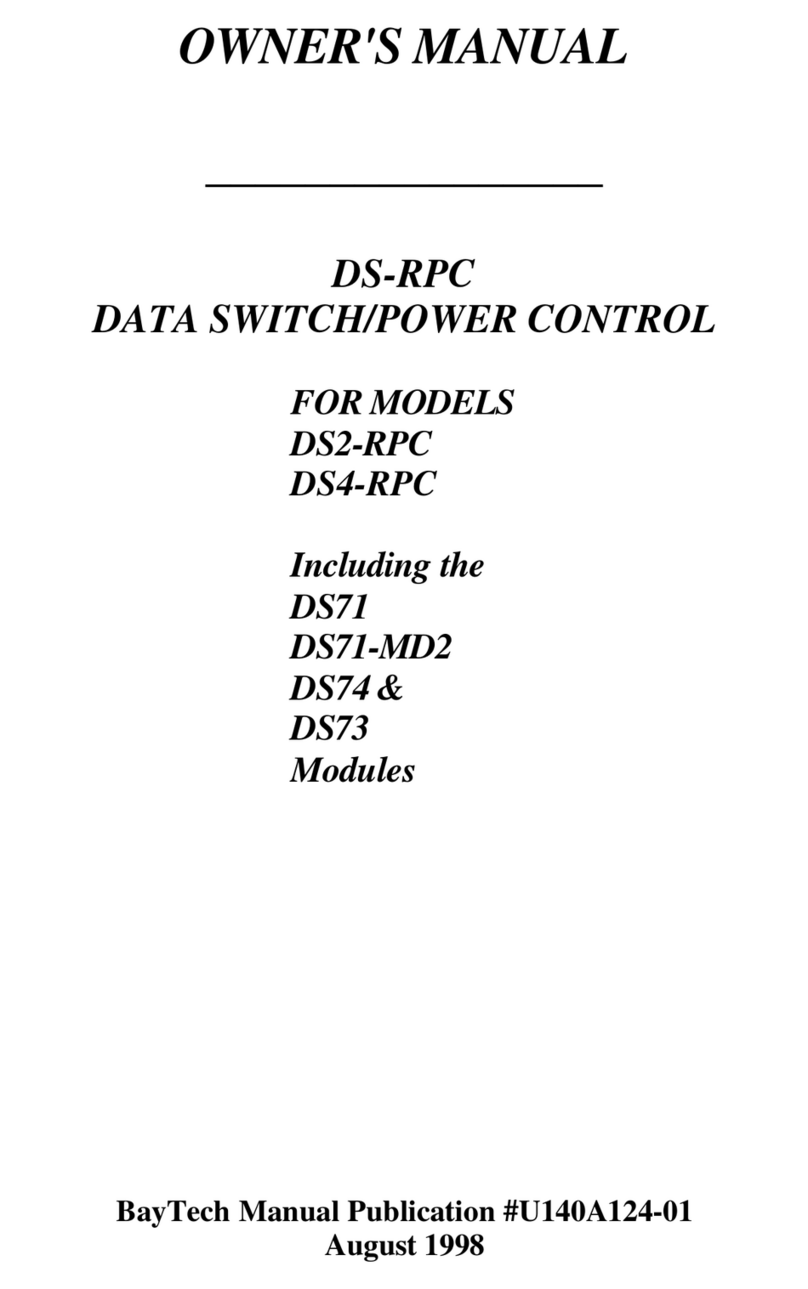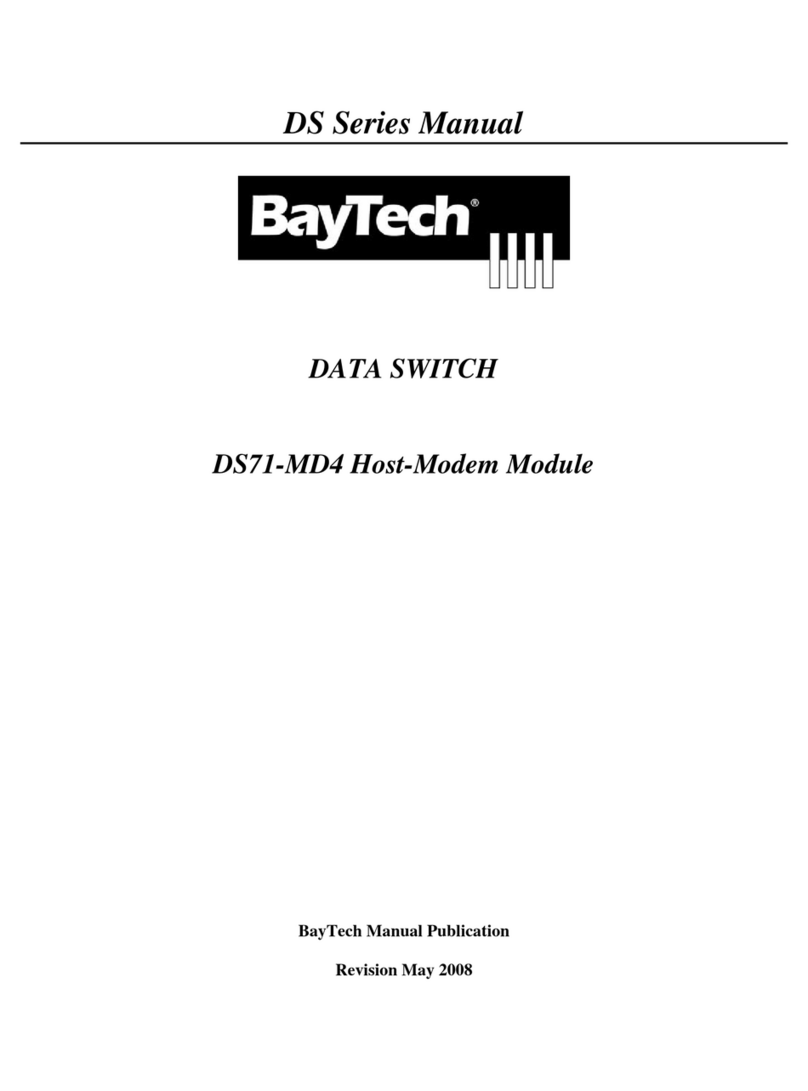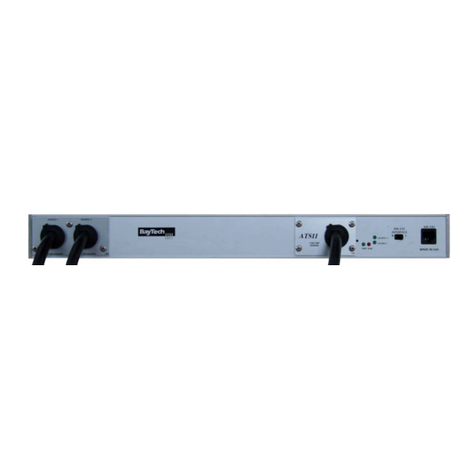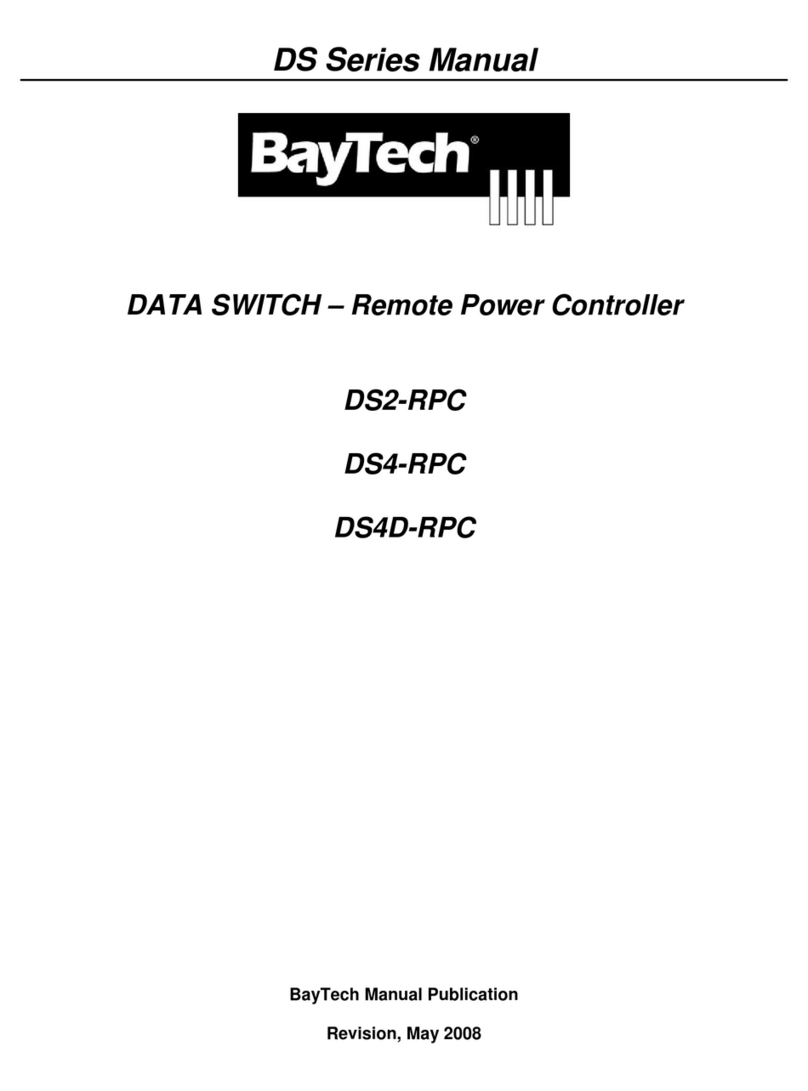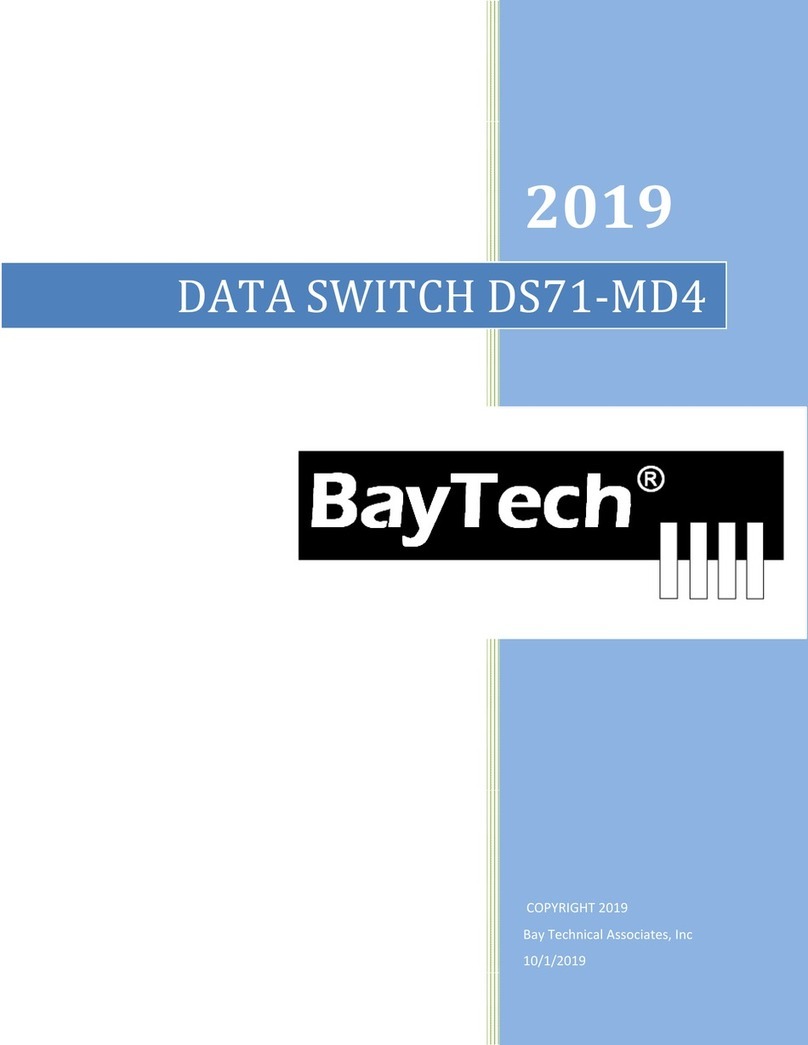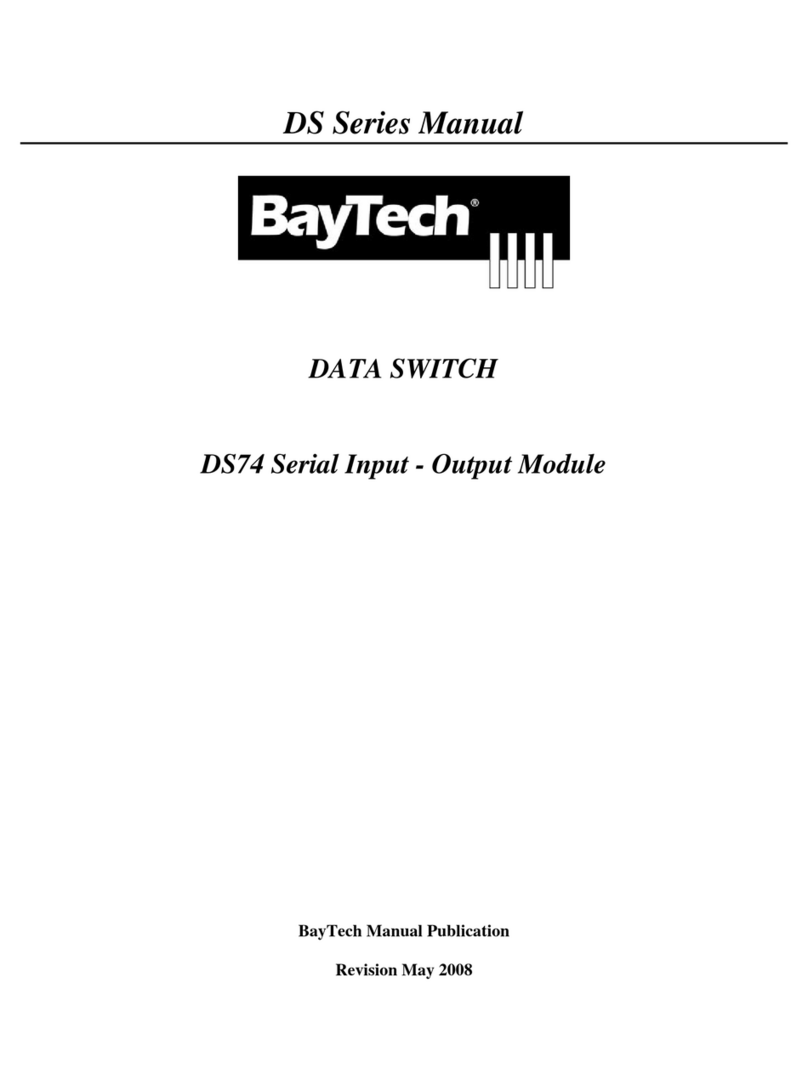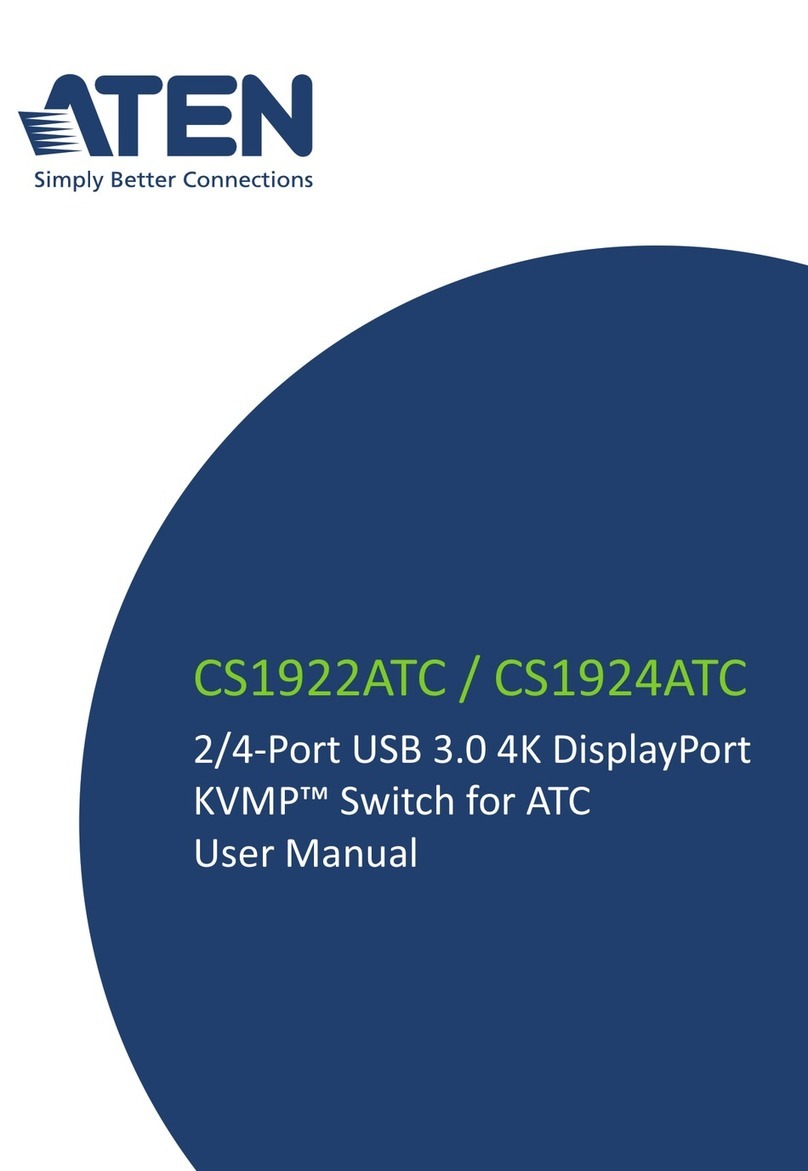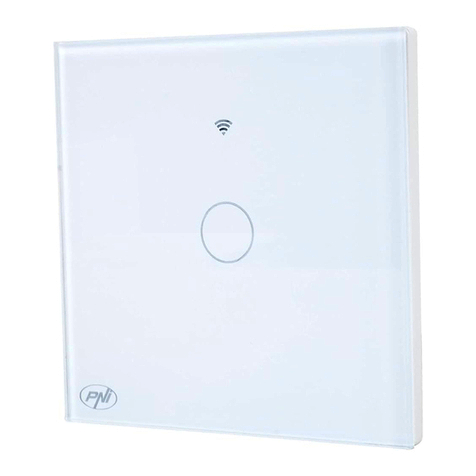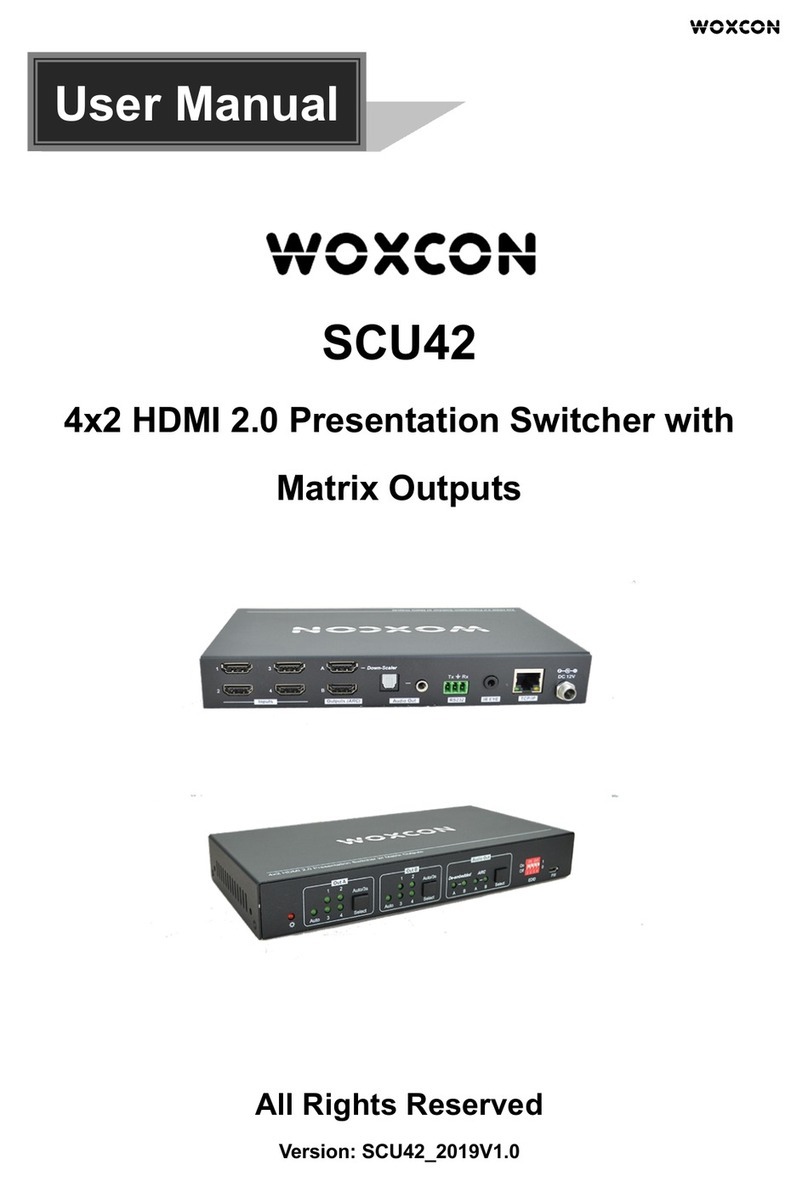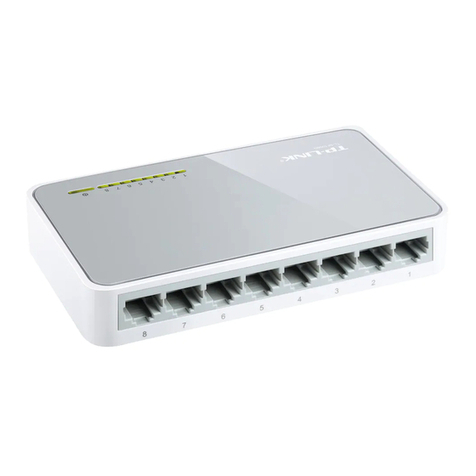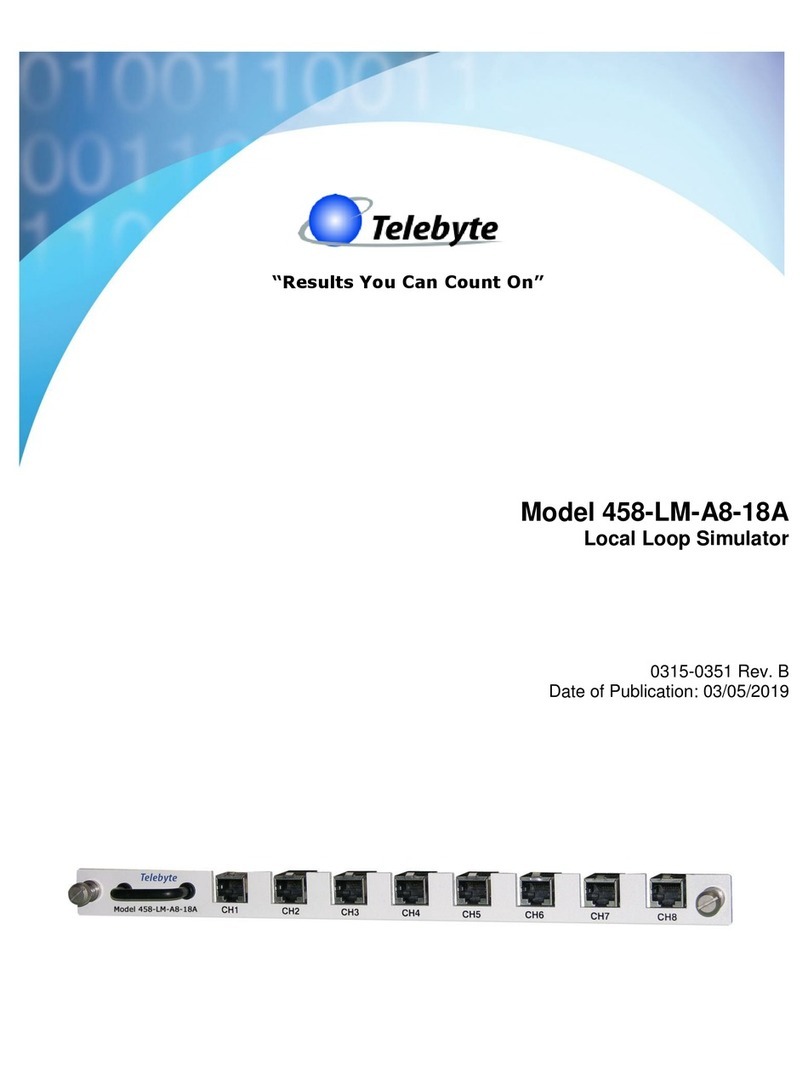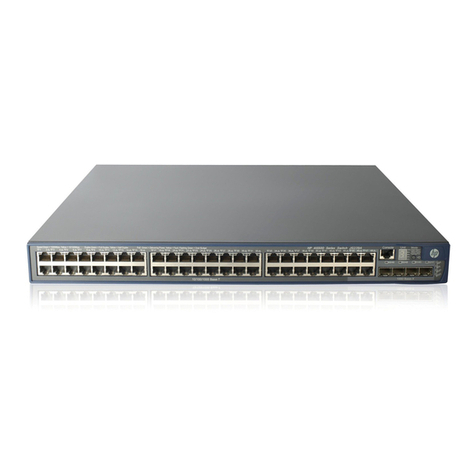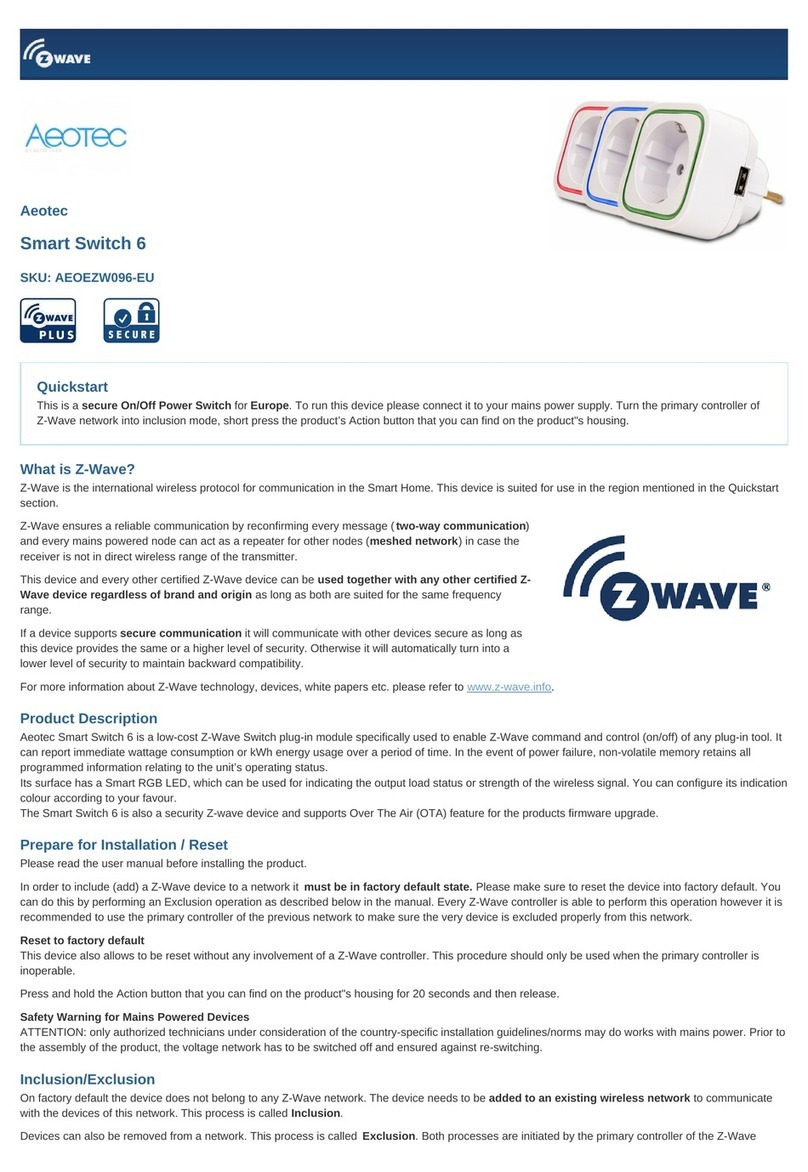BayTech DS3 User manual

OWNER'S MANUAL
________________
DS SERIES DATA SWITCH
FOR MODELS
DS3
DS6
DS9
BayTech Manual Publication #U140A121-04
July 1998

ii
Copyright 1998 by Bay Technical Associates, Inc.
BayTech, Telplex, LaserShare, Print Master and TRAN-X are
registered trademarks of Bay Technical Associates, Inc.
IBM, IBM PC, IBM PC/AT, IBM PC/XT are products and registered
trademarks of International Business Machines Corporation.
Hewlett-Packard LaserJet is a product and registered trademark of the
Hewlett-Packard Company.
PROCOMM PLUS is a product and registered trademark of Datastorm
Technologies, Inc.
Windows 95
is a product and registered trademark of Microsoft
Corporation.

DS-SERIES OWNER’S MANUAL
ABOUT THIS OWNER’S MANUAL
iii
ABOUT THIS OWNER’S MANUAL
This document provides information required for installing and operating
your Bay Tech equipment. It should allow the user to connect, power
up, and access an applications menu where peripheral equipment can be
controlled. We recommend reading this manual carefully, while placing
special emphasis on correct cabling and configuration. If you have any
problems with your installation, please contact a BayTech Applications
Engineer at 228-467-8231, call toll free from anywhere in the United
States using 1-800-523-2702 or contact us at our Web Site,
www.baytechdcd.com.
BayTech manufactures many remote site management products, data
switches, data collection multiplexers, remote power controllers, and
peripheral print sharers. If you would like information on any of these
products, please contact BayTech Customer Service at the numbers
previously listed.
Conventions used in this manual include:
CAUTION: This term is used to denote any condition that could
possibly result in physical harm to personnel or damage to
equipment.
IMPORTANT: This term is used to denote conditions that could
result in the loss of communications or to highlight the proper
functioning of equipment.
NOTE: This term is used to denote items of interest to the user.
<cr>: Carriage Return or ENTER

DS-SERIES OWNER’S MANUAL
ABOUT THIS OWNER’S MANUAL
iv
The information in this document is subject to change without notice. The
statements, configurations, technical data, and recommendations in this
document are believed to be accurate and reliable, but are presented
without express or implied warranty. Users must take full responsibility
for their applications of any products specified in this document. The
information in this document is proprietary to Bay Technical Associates,
Inc.
In the interest of improving internal design, operational function, and/or
reliability, Bay Technical Associates, Inc reserves the right to make
changes to the products described in this document without notice.
Bay Technical Associates, Inc does not assume any liability that may
occur due to the use or application of the product(s) or circuit layout(s)
described herein.
This manual replaces BayTech Publication U140A121-03 and
incorporates BayTech Addendum Z140A187.
We welcome any comments you may have about our products, and we
hope that you will continue to look to BayTech for your data
communication needs.

TABLE OF CONTENTS
v
ABOUT THIS OWNER’S MANUAL iii
INTRODUCTION TO THE DATA SWITCH 1
PROGRAMMABLE FEATURES OF THE DS SERIES 2
DS-SERIES QUICK START 5
EIA-232 SERIAL CONNECTION 5
OPERATION 5
DS SERIES MODULE CONFIGURATION 7
INSTALLATION 8
UNPACKING 8
PREPARING THE INSTALLATION SITE 8
POWER 9
CABLING 10
RJ-45 CABLES AND ADAPTERS 10
MODEM CONNECTIONS 13
DETAILED OPERATION AND CONFIGURATION 15
CONNECTING TO THE DS-SERIES 15
EIA-232 SERIAL CONNECTION 15
INTERNAL MODEM CONNECTION DS71-MD2 (ONLY) 16
EXTERNAL MODEM CONNECTION 16
10BASE-T NETWORK PORT CONNECTION 17
OPERATION 18
ACCESSING MAIN MENU 18
SELECTING A DEVICE 20
PPP DIAL-UP CONNECTION 22
CONFIGURATION 24
DS71 SERIES CONFIGURATION 24
STATUS 25
SERIAL PORT CONFIGURATION 26

TABLE OF CONTENTS
vi
DS71 27
DS71-MD2 29
PORT DEVICE NAME 32
PORT SELECT CODE 33
ATTENTION CHARACTER 34
DISCONNECT TIME GUARD 35
CONNECT PORT ID ECHO 36
LOGIN SETUP 37
DCD LOGON/LOGOFF (DS71 ONLY) 42
LOCAL MODEM SETUP (DS71-MD2 ONLY) 43
UNIT ID 47
I/O MODULES RESET 47
UNIT RESET 48
DS74 CONFIGURATION 49
SERIAL PORT CONFIGURATION 50
PORT DEVICE NAME 50
DS73 CONFIGURATION 51
MODULE IP ADDRESS 52
DIAL-UP ADDRESS 53
SUBNET MASK 54
GATEWAY 55
PRIMARY DNS 56
SECONDARY DNS 56
PRIMARY NBNS 57
SECONDARY NBNS 57
USER NAME 58
PASSWORD 58
MODULE NAME 59
TECHNICAL SUPPORT 60
EQUIPMENT SETUP 61

TABLE OF CONTENTS
vii
REPACKAGING, SHIPPING AND RETURNING TO THE
FACTORY 62
FCC RADIO FREQUENCY INTERFACE STATEMENT63
APPENDIX A – SPECIFICATIONS 65
APPENDIX B – MODEM COMMANDS 67
APPENDIX C – WINDOWS 95 TUTORIAL 69
APPENDIX D – DRAWINGS 73
APPENDIX E – EPROM UPGRADE 81
APPENDIX F – ASCII CHARACTER DEFINITION 83
INDEX 84


DS-SERIES OWNER’S MANUAL
INTRODUCTION TO THE DATA SWITCH (DS) SERIES
1
INTRODUCTION TO THE DATA SWITCH
(DS) SERIES
BayTech’s DS-Series Data Switch provides a single dialup or EIA-232
gateway to multiple EIA-232 devices. Used for accessing remote
equipment or simply switching between multiple ports, the DS-Series Data
Switch provides a full duplexconnection between the host and up to 32
peripherals. In a typical application, the host module connects to a local
or remote computer, and the peripheral port modules connect to devices
such as routers, hubs, servers, and Data Service Units (DSU’s). The
DS-Series Data Switch is also compatible with other BayTech products
including the Remote Power Control (RPC) unit.
The DS-Series Data Switch is available in three chassis sizes. The DS3,
DS6, and DS9 have 3, 6, and 9 expansion slots respectively, providing a
maximum of 8, 20, or 32 device connections.
Table 1 provides a brief description of user programmable features
available for the DS-Series Data Switch modules. Look for a detailed
description of each feature at the page number given.

DS-SERIES OWNER’S MANUAL
INTRODUCTION TO THE DATA SWITCH (DS) SERIES
2
PROGRAMMABLE FEATURES OF THE DS MODULES
Highlighted features indicate items most often programmed
FEATURE DESCRIPTION ACTION PAGE
NO.
DS71 or DS71-MD2HOSTMODULE
Serial Port
Configuration Sets serial port speed of the DS71 and
DS71-MD2 Default = 9600, 8, 1, N,
Xon/XoffDisabled
Enter baud rate, data bits,
stop bits, parity, and
Xon/Xoff
26
Port Device
Name Uniquely identifies the port (or device
connected to the port).Default = Host
EIA-232 and Host MODEM (DS71-
MD2only)
Enter the device name 32
Port Select Code ASCII character string used to select a
port or module.Default = $BT Enter Port Select Code 33
Attention
Character A character sent in sequence five times
to invoke the main menu.
Default = ;
Enter Attention Character 34
Disconnect
Time Guard Provides reliable binary data
transmission. Default = Disabled Enable/Disable Disconnect
Time Guard 35
Port ID Echo Echoes the module number and port
number when you connect to the port.
Default = Disabled
Enable/Disable Connect Port
IDEcho 36
Header
Unit information that appears upon login
Default = DS71 or DS71-MD2 Enable/Disable Header 37
Password Password protection for dial-up and
EIA-232 connections.
Default = Disabled
Enable/ Disable, and Program
Password 38
Menu Provides a menu interface for device
selection, and configuration.
Default = Enabled
Enable/DisableMenu 39
Auto Connect
Port Allows automatic connection to a
specified port upon dial-up or
EIA-232 connection.
Default = Disabled
Enable,/Disable, and Program
Auto Connect Port. 40
DCD
Logon/Logoff
(DS71only)
External modem returns to logoff state
when DCD line goes low.
Default = Enabled
Enable/Disablemenu
selection and make hardware
jumper change
42
Table 1

DS-SERIES OWNER’S MANUAL
INTRODUCTION TO THE DATA SWITCH (DS) SERIES
3
PROGRAMMABLE FEATURES OF THE DS MODULES
(con’t)
FEATURE DESCRIPTION ACTION PAGE
NO.
DS71-MD2 HOST MODULE
Ringsto
Answer(*) The number of times the modem rings
before it automatically answers.
Default = 2 rings
Enter number of rings to
auto answer 44
Modem to
Modem
Xon/Xoff(*)
ASCII character used to stop or start
transmission of data.
Default = Disabled
Enable/ Disable Modem to
Modem 44
Connectivity
Timeout(*) Configures the amount of connectivity
(5 to 255 minutes) before modem
disconnects. Default = 60 minutes
Enter timeout in minutes.
Enter 0 to disable 45
Escape
Character(*) Allows ASCII characters to be
interpreted as commands instead of data.
Default = 43 (+)
Enter the character you wish
to use as an escape 46
Unit ID Unique ID for DS-Series unit.
Default = DS71 or DS71-MD2 Enter unit ID 47
DS74 PERIPHERAL I/O MODULE
Serial Port
Configuration Sets serial port speed for each I/O port
on the DS74. Default = 9600, 8, 1, N,
Xon/Xoff Disabled, RTS/DTR Low
Enter baud rate, data bits,
stop bits, parity, Xon/Xoff,
and DTR/RTS line driver
50
Port Device
Name Unique ID for each I/O port as displayed
on the main menu. Default = Device A,
Device B, Device C, Device D, etc.
Enter port device name 50
Table 1 (con’t)

DS-SERIES OWNER’S MANUAL
INTRODUCTION TO THE DATA SWITCH (DS) SERIES
4
PROGRAMMABLE FEATURES OF THE DS MODULES
(con’t)
FEATURE DESCRIPTION ACTION PAGE
NO.
DS73TPNETWORK MODULE
Module IP
Address IP Address for the DS73TP to access the
network. Default = 0.0.0.0 Enter the IP Address in
dotted decimal format 0.0.0.0 52
Dial-in IP
Address IP Address for the network to access the
DS73TP. Default = 0.0.0.0 Enter the IP Address in
dotted decimal format 0.0.0.0 53
Subnet Mask Consists of four bytes, each byte ranging
from 0 to 255.Default = 0.0.0.0 Enter the Subnet Mask in
dotted decimal format 0.0.0.0 54
Gateway Consists of four bytes, each byte ranging
from 0 to 255.Default = 0.0.0.0 Enter the Gateway in dotted
decimal format. 0.0.0.0 55
PrimaryDNS Primary Domain Name System address.
Default = 0.0.0.0 Enter Primary DNS Address 55
SecondaryDNS Secondary Domain Name System
address. Default = 0.0.0.0 Enter Secondary DNS
Address 56
PrimaryNBNS Primary Net BIOS Name Server.
Default = 0.0.0.0 Enter Primary NBNS
Address 57
Secondary
NBNS Secondary Net BIOS Name Server.
Default = 0.0.0.0 Enter Secondary NBNS
Address 57
User Name Unique User ID. Default = user1 Enter User Name up to 8
characters 58
Password Password for the Dial-Up PPP.
Default = BTA Enter Password up to 8
characters 58
Module Name Unique ID for the module.
Default = DS73TP Enter Module Name up to 8
characters 59

DS-SERIES OWNER’S MANUAL
DSSERIESQUICKSTART
5
DS-SERIES QUICK START
This section, “Quick Start,” describes the basic steps required to set up and
configure your DS-Series. If you need to acquaint yourself further with
setup, configuration, and operations, see “Detailed Operations and
Configuration” beginning on page 15.
EIA-232 SERIAL CONNECTION
Using the 9FMJ45PC-4 adapter and the MJ08X007 (8 pin crossed) cable,
connect the serial port of your computer to the MJ-45 port labeled
“EIA-232” on the DS71 or DS71-MD2 module.
Load serial port communications software. Set serial communications
parameters to 9600 bps, 8 data bits, 1 stop bit, and no parity.
OPERATION
Accessing Main Menu Power on the DS series module. The
following header and main menu appears if
using the DS71:
Data Switch Series - F.2.01
Bay Technical Associates
Unit ID: DS71
Port Select Code:$BT
AttentionCharacter: ;
Device A (2,1)...............1
Device B (2,2)...............2
Device C (2,3)...............3
Device D (2,4)...............4
Configure.................................C
I/O Modules Reset..................RM
Unit Reset................................RU
Exit.........................…...............X, ENTER
Logout.......................................T
Enter Request:
NOTE: The DS71 and DS71-MD2 have some menus that are
different. Where this situation occurs it will be addressed.

DS-SERIES OWNER’S MANUAL
DSSERIESQUICKSTART
6
Or this menu if the DS71-MD2 is used:
Data Switch Series - F.0.13
Bay Technical Associates
Unit ID:DS71-MD2
Port Select Code: $BT
AttentionCharacter: ;
Use the “Attention Character” to display the
remainder of the menu.
Device A (2,1)...............1
Device B (2,2)...............2
Device C (2,3)...............3
Device D (2,4)...............4
Configure.................................C
I/O Modules Reset..................RM
Unit Reset................................RU
Exit.........................…...............X
Logout.......................................T
Enter Request:
NOTE: Depending on the DS series model, the menus may vary
according to the number of DS74 modules installed in the unit.
If this is not an initial set-up and Password
has already been enabled, you are prompted
to login. After logging in successfully,
access the main menu by sending the
attention character five times (;;;;;).
Selecting a Device From the main menu, select the number of
the device you wish to access, followed by
<cr>. To return to the main menu, send the
attention character five times (;;;;;).

DS-SERIES OWNER’S MANUAL
DSSERIESQUICKSTART
7
DS SERIES MODULE CONFIGURATION
Accessing Configuration From the DS-Series Main Menu, select
Menu C, “Configuration,” followed by <cr>. The
following selection menu appears:
Configuration
Module 1 ................................................1
Module 2 ................................................2
Module 3 ................................................3
Select Port .............................................S
Exit ........................................................X
Enter Request :
To configure a module, enter the number
associated with it, followed by <cr>. For
detailed configuration of each module refer
to:
DS71 or DS71-MD2 page 24
DS74 page 49
DS73 page 51

DS-SERIES OWNER’S MANUAL
INSTALLATION
8
INSTALLATION
UNPACKING
Compare the unit and serial number of the equipment you received to the
packing slip located on the outside of the box. Log this information on the
sheet on page 61. Inspect equipment carefully for damage that may have
occurred in shipment. If there is damage to the equipment or if materials
are missing, contact BayTech customer service at 228-467-8231 or call
toll free inside the United States at 800-523-2702. At a minimum, you
should receive the following:
a. The DS-Series Unit
b. This manual with any applicable addendum(s).
c. 1 ea 9FMJ45PC4 adapter
d. 1 ea MJ08X007(MJ45) cable
e. 1 ea #AA1580-5 (XFO028 ) 15 VAC transformer
f. 1 ea RJ-11 telco cable -- RJ04X007 (DS71-MD2 only).
g. 1 ea 25MMJ45MD-6 adapter (DS71 only)
NOTE: Keep the shipping container and packing material in the
event future shipment is required.
PREPARING THE INSTALLATION SITE
The installation area should be clean and free of extreme temperatures and
humidity. Allow sufficient space behind the unit for cabling.

DS-SERIES OWNER’S MANUAL
INSTALLATION
9
POWER
CAUTION: This unit is intended for indoor use only. Do not
install near water or expose this unit to moisture. To prevent heat
buildup, do not coil the power cord when in use. Do not use
extension cords. Do not attempt to make any internal changes to
the power source. Do not attempt to modify any portion or
component of a DS-Series Data Switch unless specifically directed
to; as in Appendix E of this manual. BayTech must perform any
internal changes.
CAUTION:High-voltage surges and spikes can damage this
equipment. To protect from such power surges and spikes, this
unit must have a good earth ground. A grounding screw connection
is located near the power switch on the back of the unit.
CAUTION:Before removing or replacing any modules, turn off
main power switch located on the DS-Series Base Unit.
Communication to the DS-Series Data Switch will be disrupted
while power is off.

DS-SERIES OWNER’S MANUAL
CABLING
10
CABLING
MJ-45 CABLES AND ADAPTERS
IMPORTANT: The DS-Series host communications modules
have an MJ-45 port which uses an 8-pin crossed modular cable to
connect to a local EIA-232 device such as a computer terminal or
external modem. Most serial computers do not have MJ-45
connections; therefore an adapter is provided with this unit to
convert from a DE-9 connector to an MJ-45 connector (Bay Tech
Part No. 9FMJ45PC-4). An adapter to convert from a DB-25
connector to an MJ-45 connector is also available from Bay Tech,
upon request (Bay Tech Part No. 25FMJ45PC-4). The 8-pin
crossed modular cable is configured to operate with these adapters.
CAUTION:All power should be removed from the DS Series
unit prior to removing or installing cables.
Figures 1 and 2 provide visual representation of an MJ-45 receptacle and
plug; pin number assignments are given in Table 2.
Fig.1: MJ-45 Receptacle Fig. 2: MJ-45 Plug
DS73TP CONNECTION
You should connect a straight cable between the MJ-45 ports of the
DS73TP module and the network hub. The “LINK” light will light
green when a good link has been established.

DS-SERIES OWNER’S MANUAL
CABLING
11
Tables 2 and 3 define the pin layout for the DS71 or DS71-MD2 and
DS74.
DS71 EIA-232 MJ-45 Pin/Signal Definition
Pin EIA-232
Signal Description
1Handshake
Out (DTR) Line Driver Inactive State = High: +12V when power is
applied. Used as a handshake line to enable/disable the receiving of
characters.
2Gnd Signal ground
3Handshake
Out (RTS) Line Driver Inactive State = High: +12 V when power is
applied. Not used to enable/disable.
4TX Out Transmit Data (data out)
5RX In Receive Data (data in)
6Handshake
In (DSR) Handshake In. –12V when not used.
7Gnd or
DCD In Signal ground when Jumper JP6-2 is connected to JP6-3. In order
for the DS71 to take advantage of “DCD Logon/Logoff” and “Auto
Connect Port”, Jumper JP6-2 is connected to JP6-1 providing DCD
In.
8Handshake
In (CTS) Used as a handshake line to enable/disable the receiving of
characters.
Table 2 DS71 PIN SIGNAL DEFINITION

DS-SERIES OWNER’S MANUAL
CABLING
12
DS74 EIA-232 MJ-45 Pin/Signal Definition
Pin EIA-232
Signal Description
1Handshake
Out (DTR) Line Driver Inactive State = Low: Used as a handshake line
to enable/disable the receiving of characters. –12V when port is not
selected unless programmed differently.
2Gnd Signal ground
3Handshake
Out (RTS) Line Driver Inactive State = Low: Used as a handshake line.
–12V when port is not selected unless programmed differently.
4TX Out Transmit Data (data out)
5RX In Receive Data (data in)
6Handshake
In (DSR) Handshake In. +12V when not used.
7Gnd Signal ground
8Handshake
In (CTS) Used as a handshake line to enable/disable the receiving of
characters.
Table 3 DS74 PIN SIGNAL DEFINITION
The DS74 module has four MJ-45 ports for connecting to
peripheral devices. BayTech has a complete line of modular
adapters and cables that may be helpful with your installation. For
more information on these cables and adapters, contact BayTech’s
Applications Engineers.
This manual suits for next models
2
Table of contents
Other BayTech Switch manuals
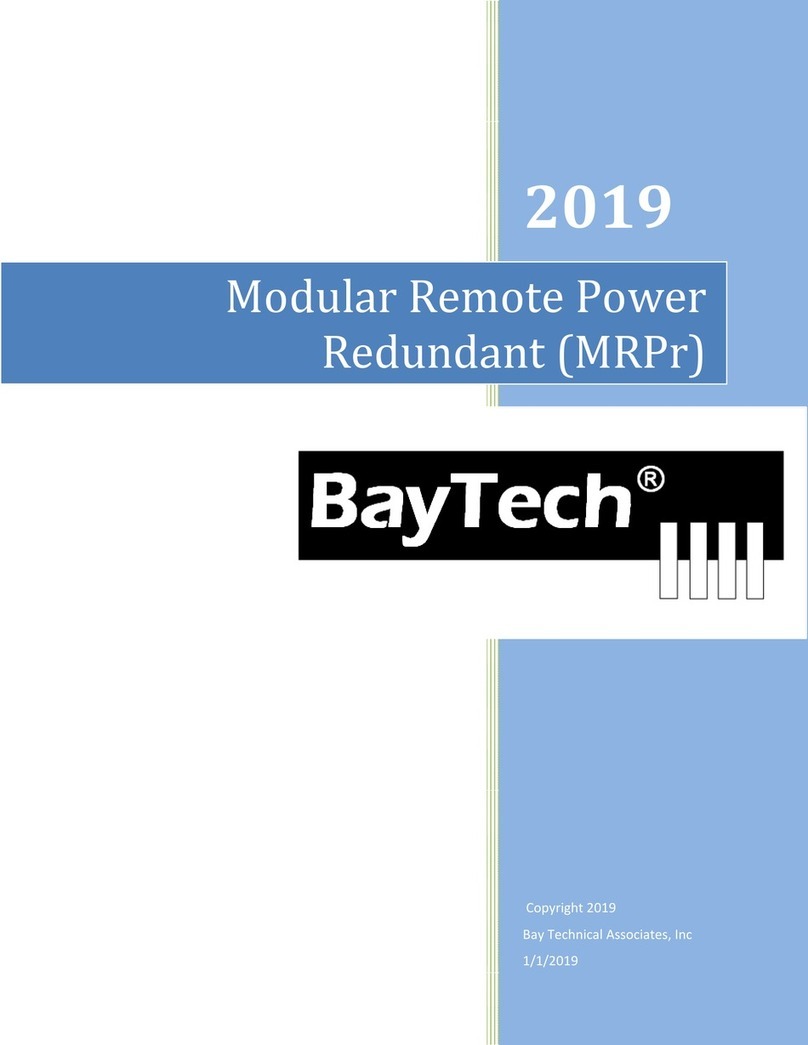
BayTech
BayTech MRPr User manual
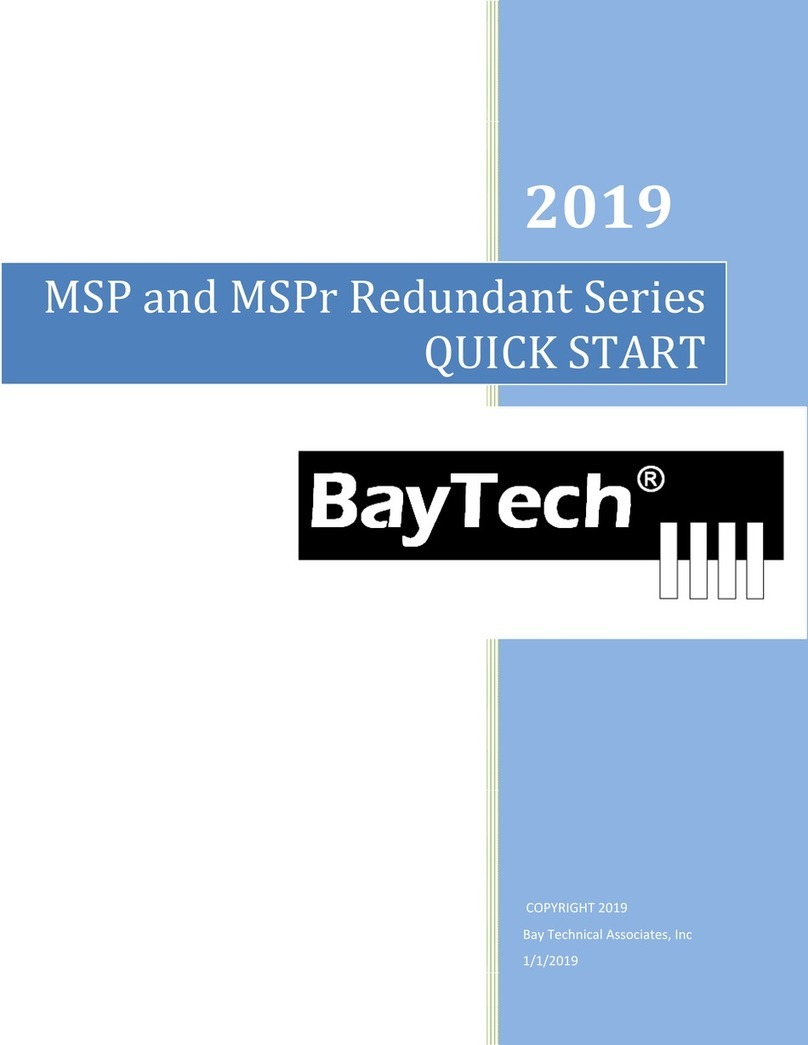
BayTech
BayTech MSP Series User manual

BayTech
BayTech MMP User manual
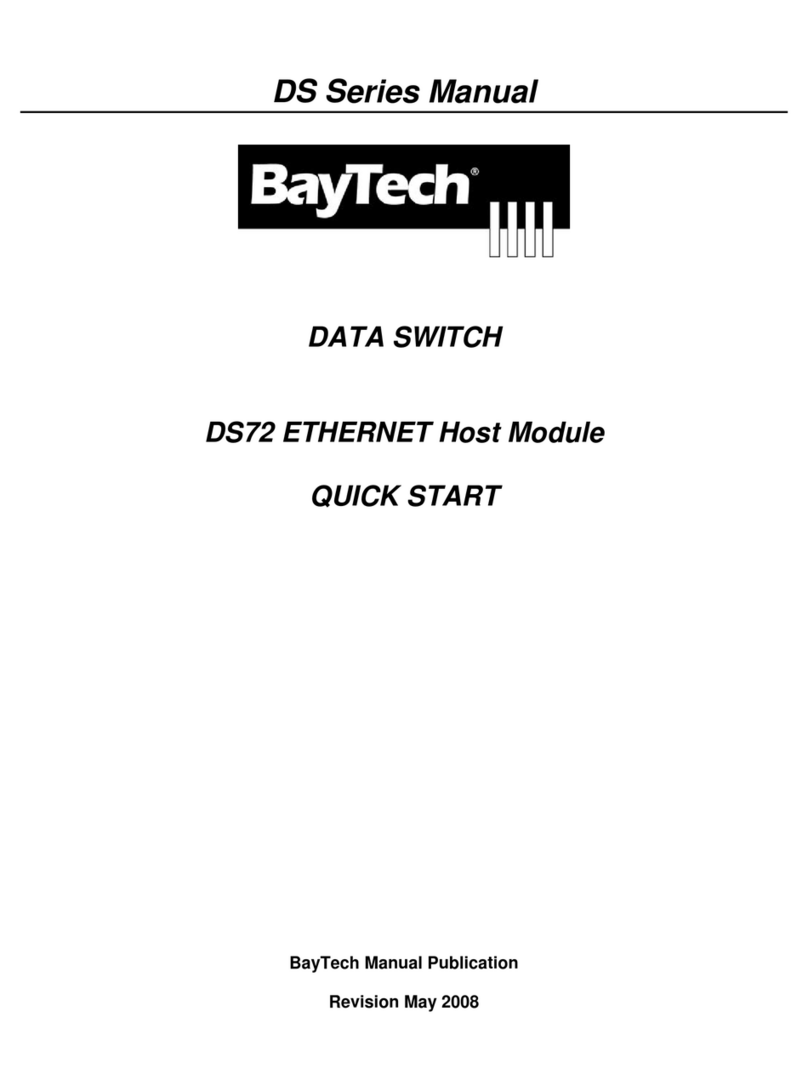
BayTech
BayTech DS72 User manual
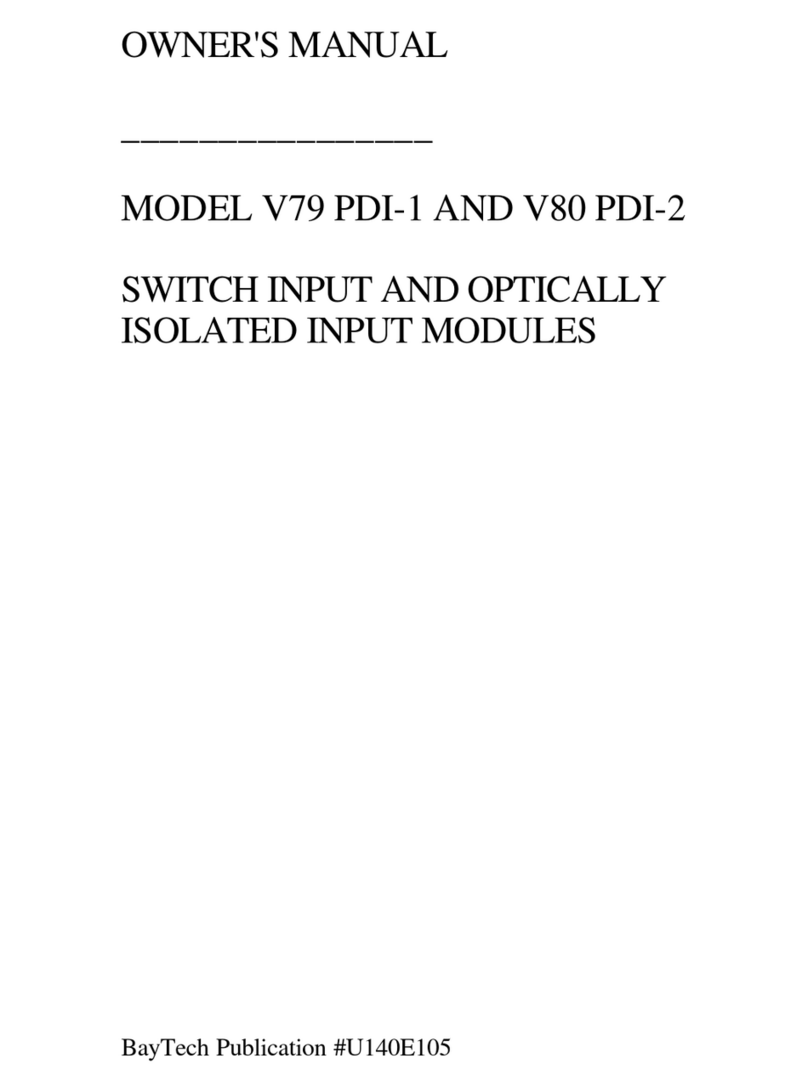
BayTech
BayTech V79 PDI-1 User manual
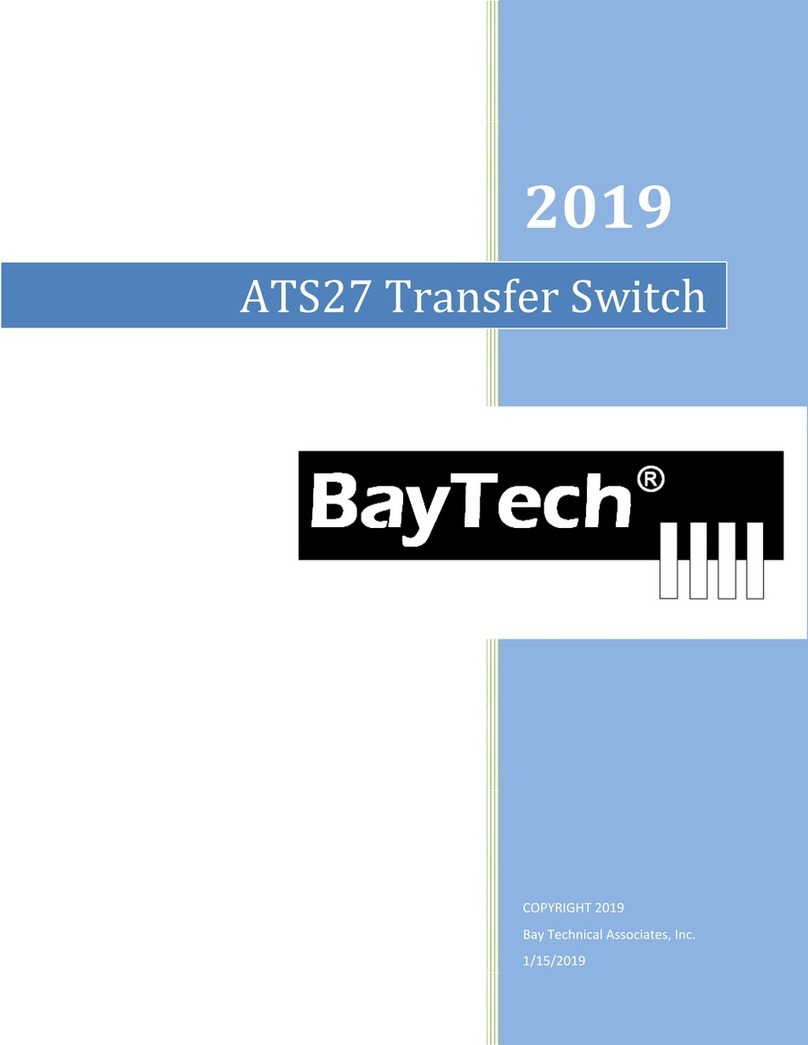
BayTech
BayTech ATS27 User manual
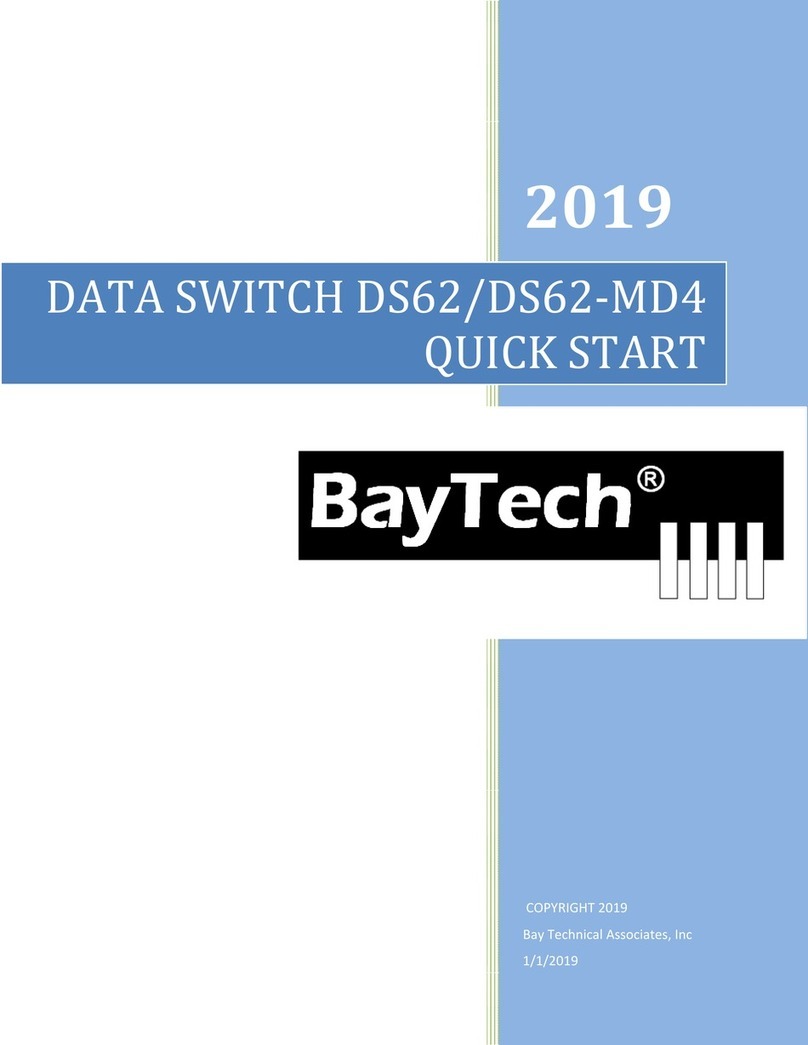
BayTech
BayTech BayTech DS62 User manual
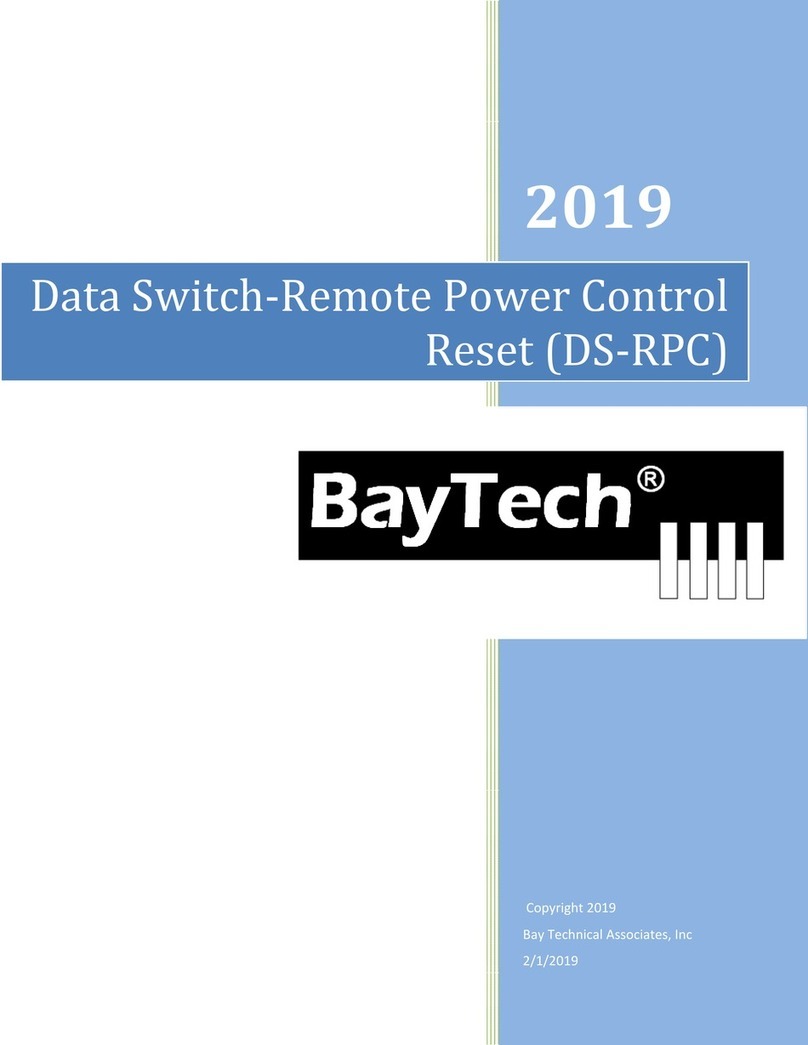
BayTech
BayTech DS-RPC User manual
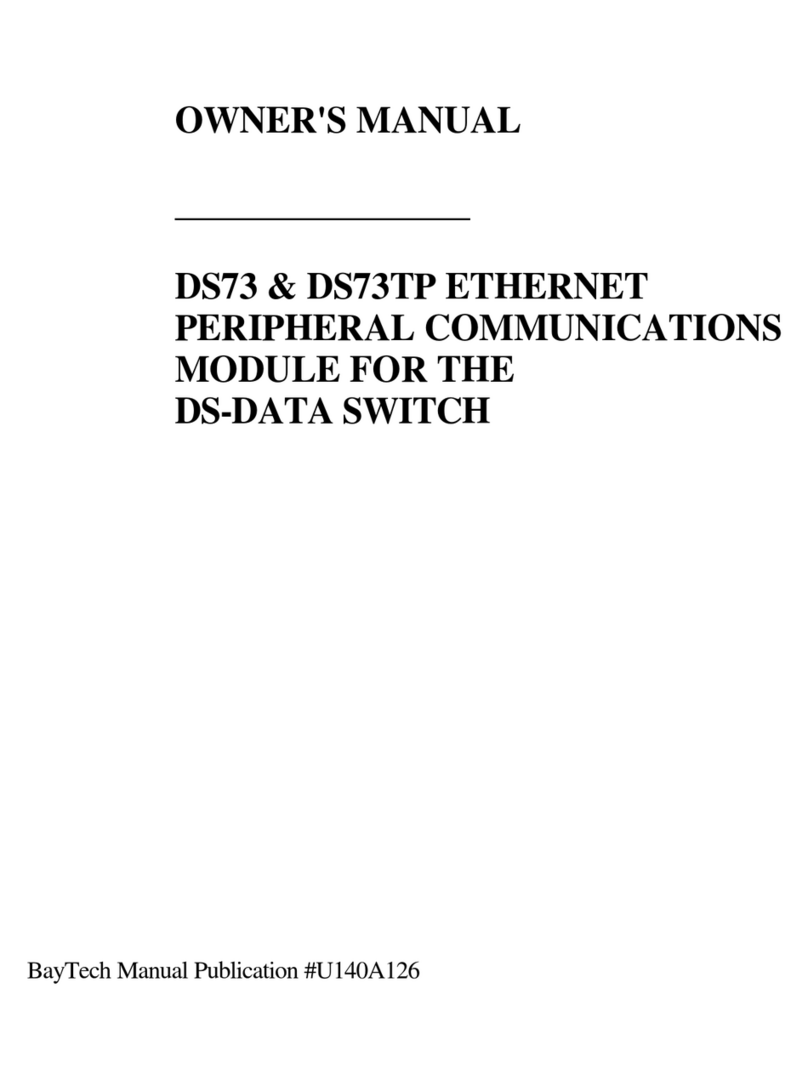
BayTech
BayTech DS73 User manual

BayTech
BayTech MMPr User manual
Popular Switch manuals by other brands
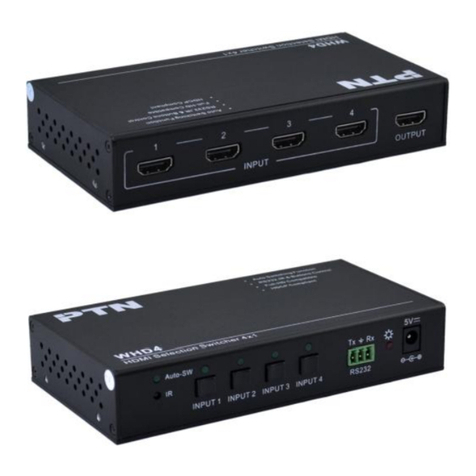
PTN
PTN WHD4 user manual
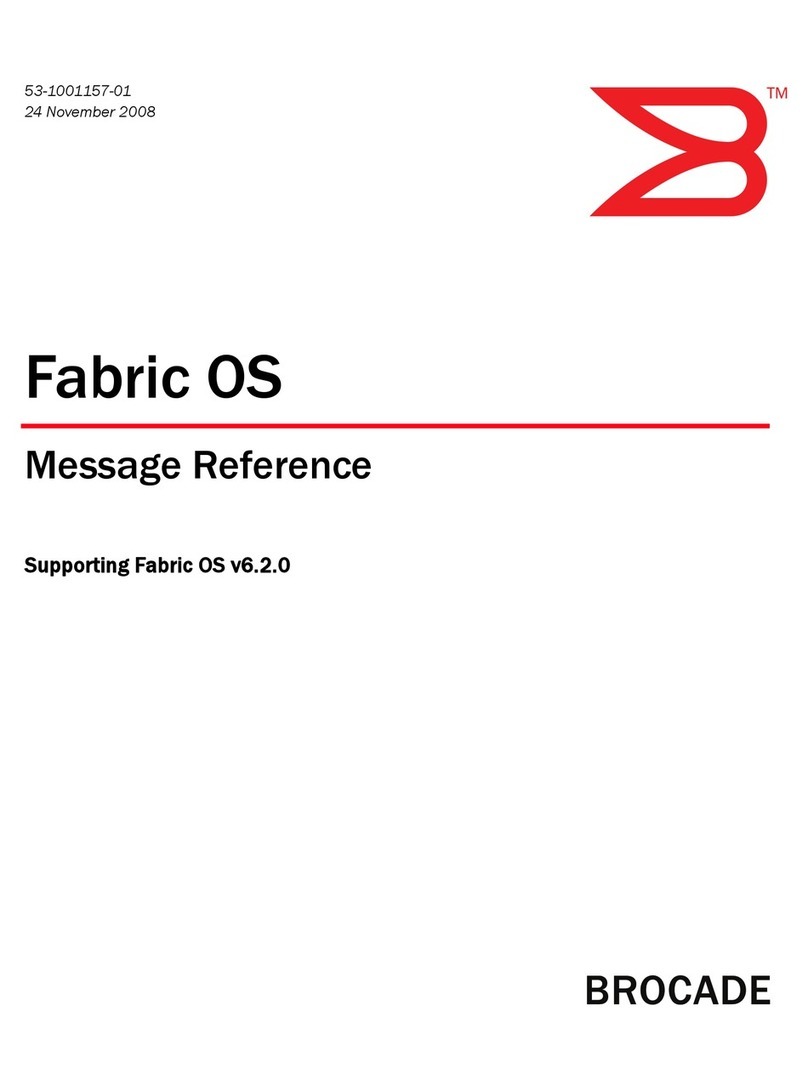
Brocade Communications Systems
Brocade Communications Systems A7533A - Brocade 4Gb SAN Switch Base reference guide

KYLAND
KYLAND SICOM3014GV Hardware installation manual
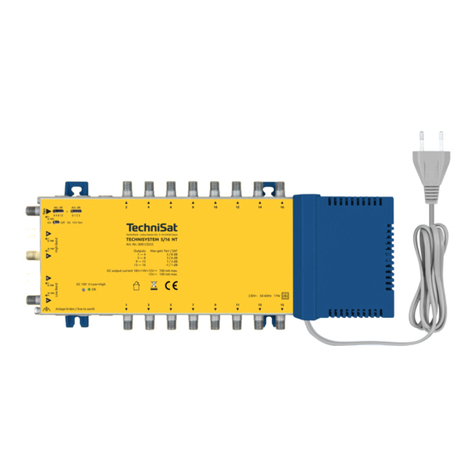
TechniSat
TechniSat TECHNISYSTEM 5/16 NT quick start guide
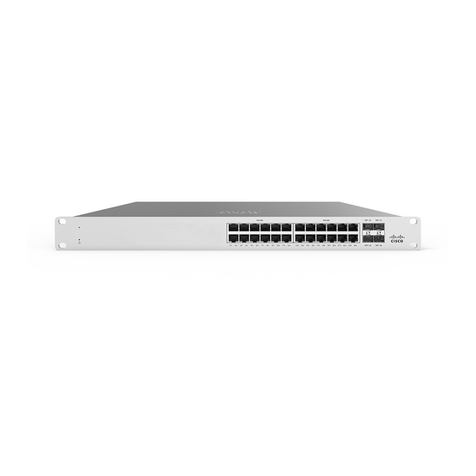
Cisco
Cisco Meraki MS125 Series installation guide
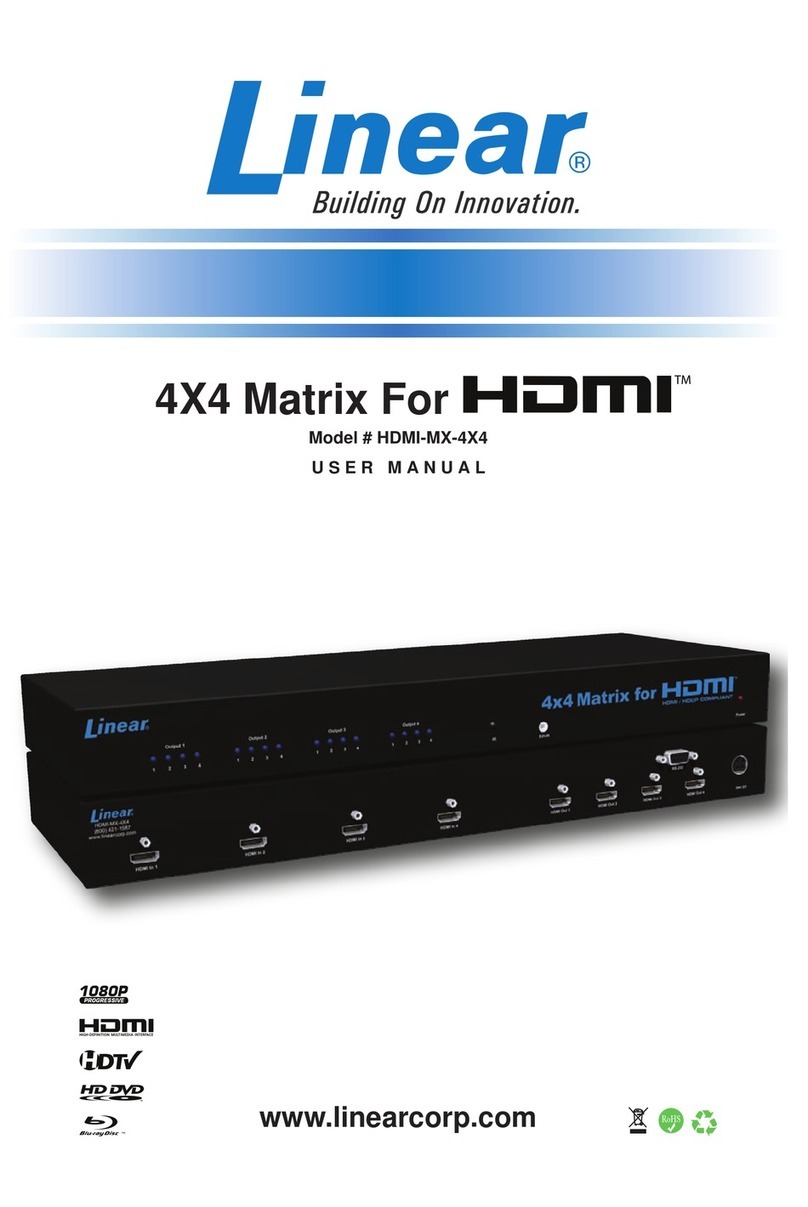
Linear
Linear HDMI-MX-4x4 user manual
